Time-Division Multiplexed Optical Covert Communication System Based on Gain-Switched Optical Pulses
Abstract
1. Introduction
2. Optical Time-Division Multiplexing Optical Covert Signal
3. Optical Covert Communication System
4. Simulation Results and Discussion
4.1. Multiple Users
4.2. Single User
5. Discussions and Conclusions
Author Contributions
Funding
Institutional Review Board Statement
Informed Consent Statement
Data Availability Statement
Conflicts of Interest
References
- Argyris, A.; Syvridis, D.; Larger, L.; Annovazzi-Lodi, V.; Colet, P.; Fischer, I.; Garcia-Ojalvo, J.; Mirasso, C.R.; Pesquera, L.; Shore, K.A. Chaos-based communications at high bit rates using commercial fibre-optic links. Nature 2005, 438, 343–346. [Google Scholar] [CrossRef]
- Pal, B.; Baruah, S.; Dikshit, B. Synchronization of complexity enhanced chaos in semiconductor lasers. Phys. Scr. 2024, 99, 015525. [Google Scholar] [CrossRef]
- Zhang, Y.; Xu, M.; Pu, M.; Zhou, M.; Ding, J.; Chen, S.; Qiu, K.; Jiang, N.; Luo, X. Simultaneously enhancing capacity and security in free-space optical chaotic communication utilizing orbital angular momentum. Photonics Res. 2023, 11, 2185–2193. [Google Scholar] [CrossRef]
- Deng, Z.; Gao, X.; An, Y.; Wang, A.; Fu, S.; Wang, Y.; Yuwen, Q.; Gao, Z. High-speed secure key distribution based on interference spectrum-shift keying with signal mutual modulation in commonly driven chaos synchronization. Opt. Express 2023, 31, 42449–42463. [Google Scholar] [CrossRef]
- Li, N.; Nguimdo, R.M.; Locquet, A.; Citrin, D.S. Enhancing optical-feedback-induced chaotic dynamics in semiconductor ring lasers via optical injection. Nonlinear Dyn. 2018, 92, 315–324. [Google Scholar] [CrossRef]
- Abd El-Mottaleb, S.A.; Singh, M.; Atieh, A.; Aly, M.H. Performance evaluation of a UOWC system based on the FRS/OCDMA code for different types of Jerlov waters. Appl. Opt. 2024, 63, 762–771. [Google Scholar] [CrossRef]
- Ji, J.; Wu, B.; Zhang, J.; Xu, M.; Wang, K. Design and Investigation of 10 Gb/s FSO Wiretap Channel Using OCDMA Time-Diversity Reception. IEEE Photonics J. 2020, 12, 7903212. [Google Scholar] [CrossRef]
- Ahmed, M.S.; Glesk, I. Management of OCDMA Auto-Correlation Width by Chirp Manipulation Using SOA. IEEE Photonics Technol. Lett. 2018, 30, 785–788. [Google Scholar] [CrossRef]
- Li, Y.; Li, Y.; Zhu, K.; Wei, S.; Zhang, M.; Zhao, Y.; Zhang, J. Integrating key generation and distribution with the quantum noise stream cipher system without compromising the transmission performance. Opt. Lett. 2023, 48, 6500–6503. [Google Scholar] [CrossRef]
- Yoshida, M.; Kan, T.; Kasai, K.; Hirooka, T.; Nakazawa, M. 10 Tbit/s QAM Quantum Noise Stream Cipher Coherent Transmission Over 160 Km. J. Light. Technol. 2021, 39, 1056–1063. [Google Scholar] [CrossRef]
- Tanizawa, K.; Futami, F. IF-Over-Fiber Transmission of OFDM Quantum-Noise Randomized PSK Cipher for Physical Layer Encryption of Wireless Signals. J. Light. Technol. 2022, 40, 1698–1704. [Google Scholar] [CrossRef]
- Zhu, K.; Wei, S.; Li, Y.; Li, Y.; Wang, Y.; Zhao, Y.; Zhang, J. Quantum Noise Stream Cipher Scheme With Triangular Quadrature Amplitude Modulation and Secret Probabilistic Shaping. J. Light. Technol. 2024, 42, 1423–1433. [Google Scholar] [CrossRef]
- Ban, D.C.; Huang, Q.C.; Chen, Y.F.; Qi, Y.C.; Chen, W.; Zhu, N.H. A Novel Optical Frequency-Hopping Scheme Based on a Flexible Structure for Secure Optical Communications. IEEE Photonics J. 2019, 11, 1–7. [Google Scholar] [CrossRef]
- Darabi, E.; Keshavarz, H.; Monteiro, P. A Novel Reconfigurable Nonlinear Cascaded MZM Mixer, Amplitude Shift Key Modulator (ASK), Frequency Hopping and Phase Shifter. Photonics 2023, 10, 916. [Google Scholar] [CrossRef]
- Wang, J.; Jin, Y.; Xie, Z.; Chen, Y.; Liu, Y.; Zhu, N. Secure FSO communication based on optical frequency-hopping technology using delay interferometers. Opt. Commun. 2024, 550, 129939. [Google Scholar] [CrossRef]
- Klicnik, O.; Munster, P.; Horvath, T. Multiplexing Quantum and Classical Channels of a Quantum Key Distribution (QKD) System by Using the Attenuation Method. Photonics 2023, 10, 1265. [Google Scholar] [CrossRef]
- Zheng, Z.; Guo, X.; Lin, F.; Wang, Y.; Wang, Y.; Guo, Y. Parallel CV-QRNG with Strict Entropy Evaluation. Photonics 2023, 10, 786. [Google Scholar] [CrossRef]
- Zhu, H.; Liu, Z.; Chen, S.; Xu, X.; Li, F. Optical stealth communication based on quantum noise stream ciphered amplified spontaneous emission light. Opt. Express 2023, 31, 3595. [Google Scholar] [CrossRef]
- Yen, C.T.; Huang, J.F.; Zhang, W.Z. Hiding Stealth Optical CDMA Signals in Public BPSK Channels for Optical Wireless Communication. Appl. Sci. 2018, 8, 1731. [Google Scholar] [CrossRef]
- Zhu, H.; Liu, Z.; Xiang, P.; Chen, S.; Li, F.; Xu, X. Quantum noise ciphered optical stealth communication based on equivalent spectral encoding. Opt. Express 2022, 30, 38128. [Google Scholar] [CrossRef]
- Laka, P.; Maksymiuk, L. Steganographic transmission in optical networks with the use of direct spread spectrum technique. Secur. Commun. Netw. 2016, 9, 771–780. [Google Scholar] [CrossRef]
- Liu, Z.; Zhu, H.; Zhang, X.; Chen, S.; Xu, X.; Li, F. Subnoise optical covert communication based on amplified spontaneous emission light. Opt. Express 2023, 31, 40261. [Google Scholar] [CrossRef]
- Senkans, U.; Bobrovs, V.; Ivanovs, G.; Spolitis, S. Research of hybrid WDM-PON data transmission system with embedded ASE-powered stealth channels for steganography applications. Opt. Fiber Technol. 2020, 58, 102300. [Google Scholar] [CrossRef]
- Wu, B.; Wang, Z.; Tian, Y.; Fok, M.P.; Shastri, B.J.; Kanoff, D.R.; Prucnal, P.R. Optical steganography based on amplified spontaneous emission noise. Opt. Express 2013, 21, 2065–2071. [Google Scholar] [CrossRef] [PubMed]
- Huang, C.; Ma, P.Y.; Shastri, B.J.; Mittal, P.; Prucnal, P.R. Robustness of Optical Steganographic Communication Under Coherent Detection Attack. IEEE Photonics Technol. Lett. 2019, 31, 327–330. [Google Scholar] [CrossRef]
- Hong, X.; Wang, D.; Xu, L.; He, S. Demonstration of optical steganography transmission using temporal phase coded optical signals with spectral notch filtering. Opt. Express 2010, 18, 12415–12420. [Google Scholar] [CrossRef]
- Zhu, H.; Wang, R.; Pu, T.; Fang, T.; Xiang, P.; Zheng, J.; Chen, D. Optical stealth transmission based on super-continuum generation in highly nonlinear fiber over WDM network. Opt. Lett. 2015, 40, 2561–2563. [Google Scholar] [CrossRef]
- Wohlgemuth, E.; Yoffe, Y.; Goki, P.N.; Imran, M.; Fresi, F.; Poti, L.; Sadot, D. Demonstration of Stealthy and Encrypted Optical Transmission Below Adjacent 50 GHz DWDM Channels. IEEE Photonics Technol. Lett. 2020, 32, 581–584. [Google Scholar] [CrossRef]
- Wohlgemuth, E.; Yoffe, Y.; Yeminy, T.; Zalevsky, Z.; Sadot, D. Demonstration of coherent stealthy and encrypted transmission for data center interconnection. Opt. Express 2018, 26, 7638–7645. [Google Scholar] [CrossRef]
- Fok, M.P.; Wang, Z.; Deng, Y.; Prucnal, P.R. Optical Layer Security in Fiber-Optic Networks. IEEE Trans. Inf. Forensics Secur. 2011, 6, 725–736. [Google Scholar] [CrossRef]
- Wang, X.; Mou, W.; Zhu, H. Effect of Laser Parameters on Optical Stealth Transmission System Performance. Sensors 2021, 21, 5358. [Google Scholar] [CrossRef] [PubMed]
- Wu, B.; Tait, A.N.; Chang, M.P.; Prucnal, P.R. WDM optical steganography based on amplified spontaneous emission noise. Opt. Lett. 2014, 39, 5925–5928. [Google Scholar] [CrossRef] [PubMed]
- Schunk, N.; Petermann, K. Noise analysis of injection-locked semiconductor injection lasers. IEEE J. Quantum Electron. 1986, 22, 642–650. [Google Scholar] [CrossRef]
- Fatadin, I.; Ives, D.; Wicks, M. Numerical Simulation of Intensity and Phase Noise From Extracted Parameters for CW DFB Lasers. IEEE J. Quantum Electron. 2006, 42, 934–941. [Google Scholar] [CrossRef]
- Cartledge, J.C.; Srinivasan, R.C. Extraction of DFB laser rate equation parameters for system simulation purposes. J. Light. Technol. 1997, 15, 852–860. [Google Scholar] [CrossRef]

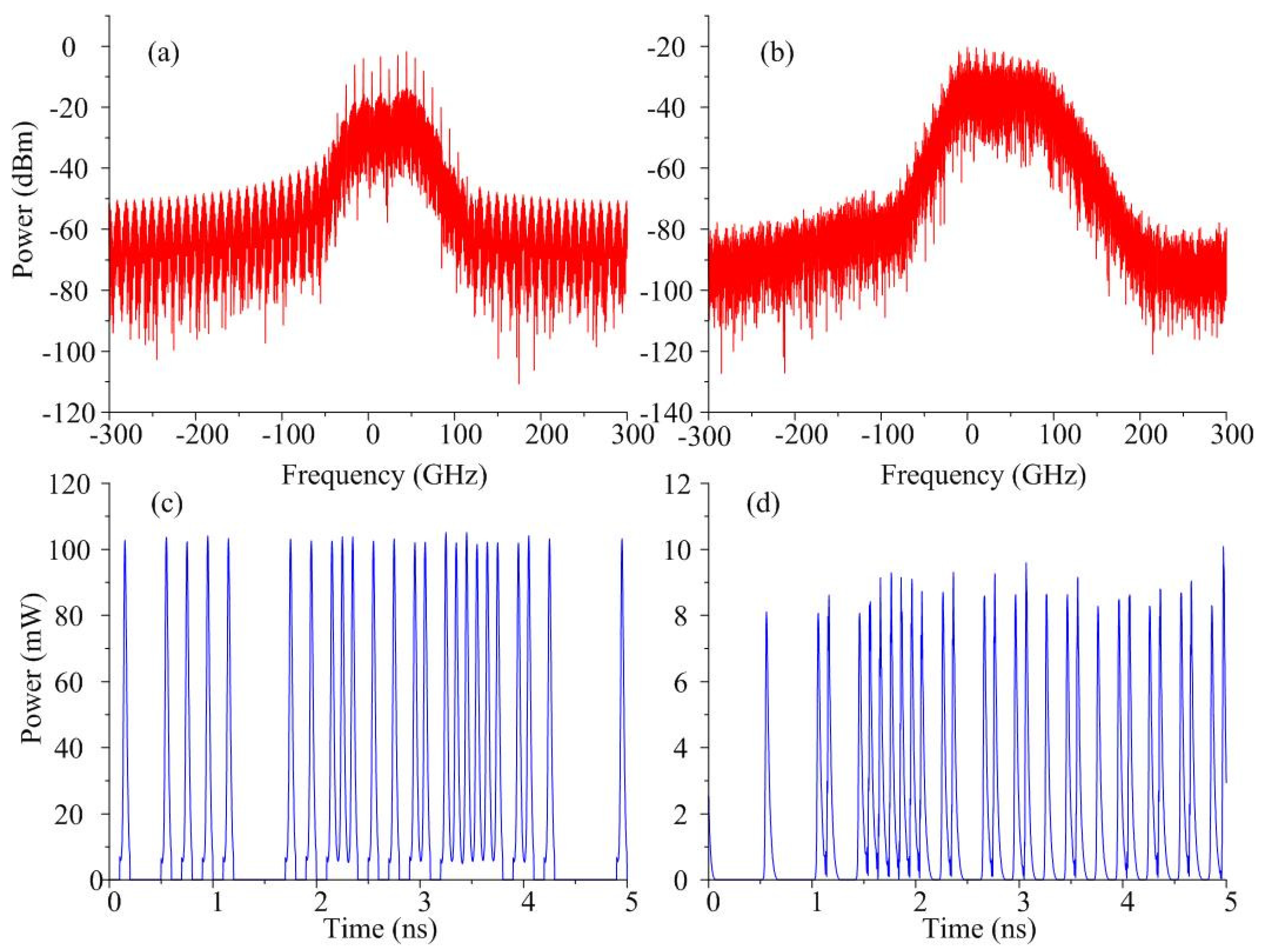
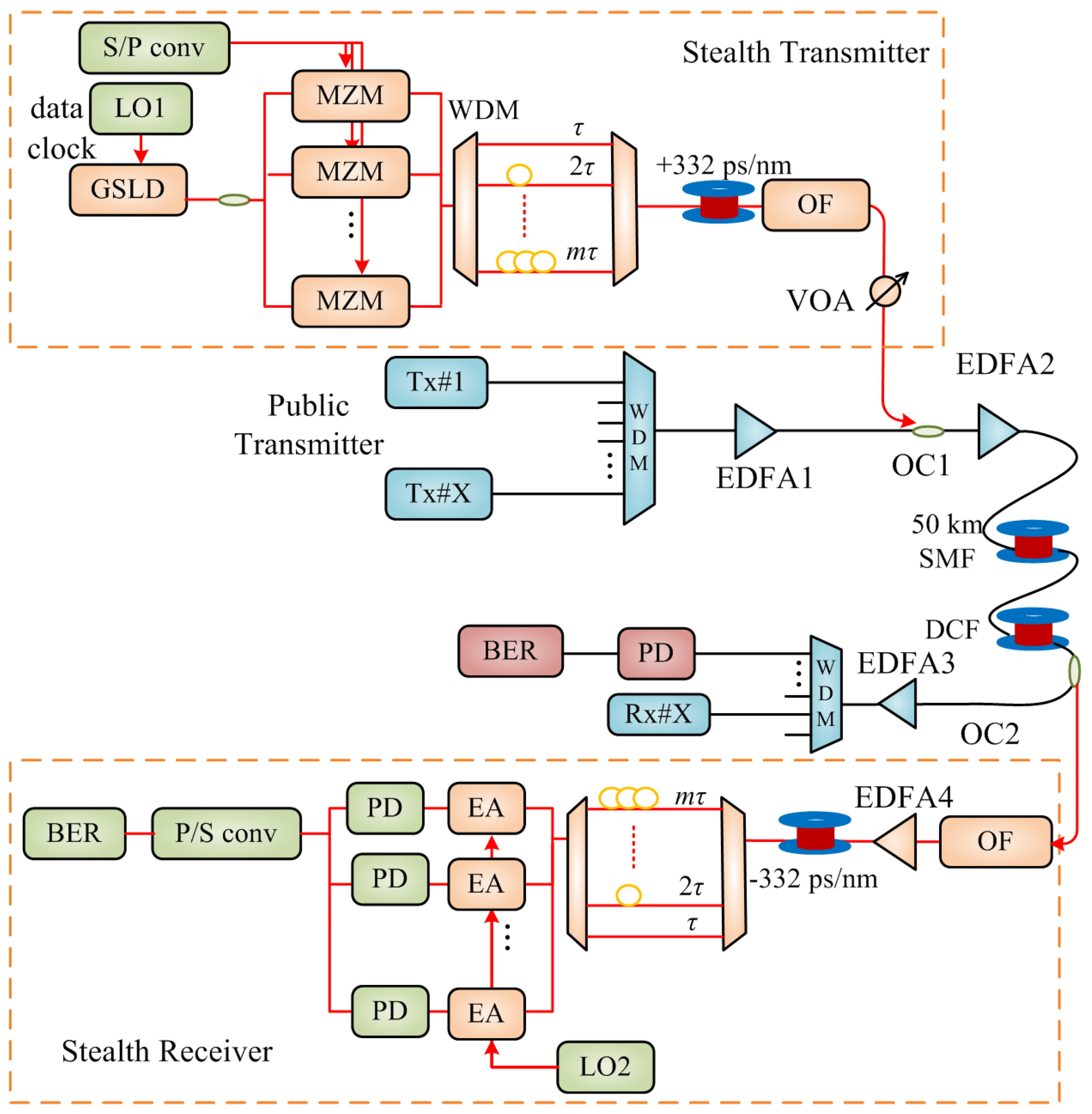

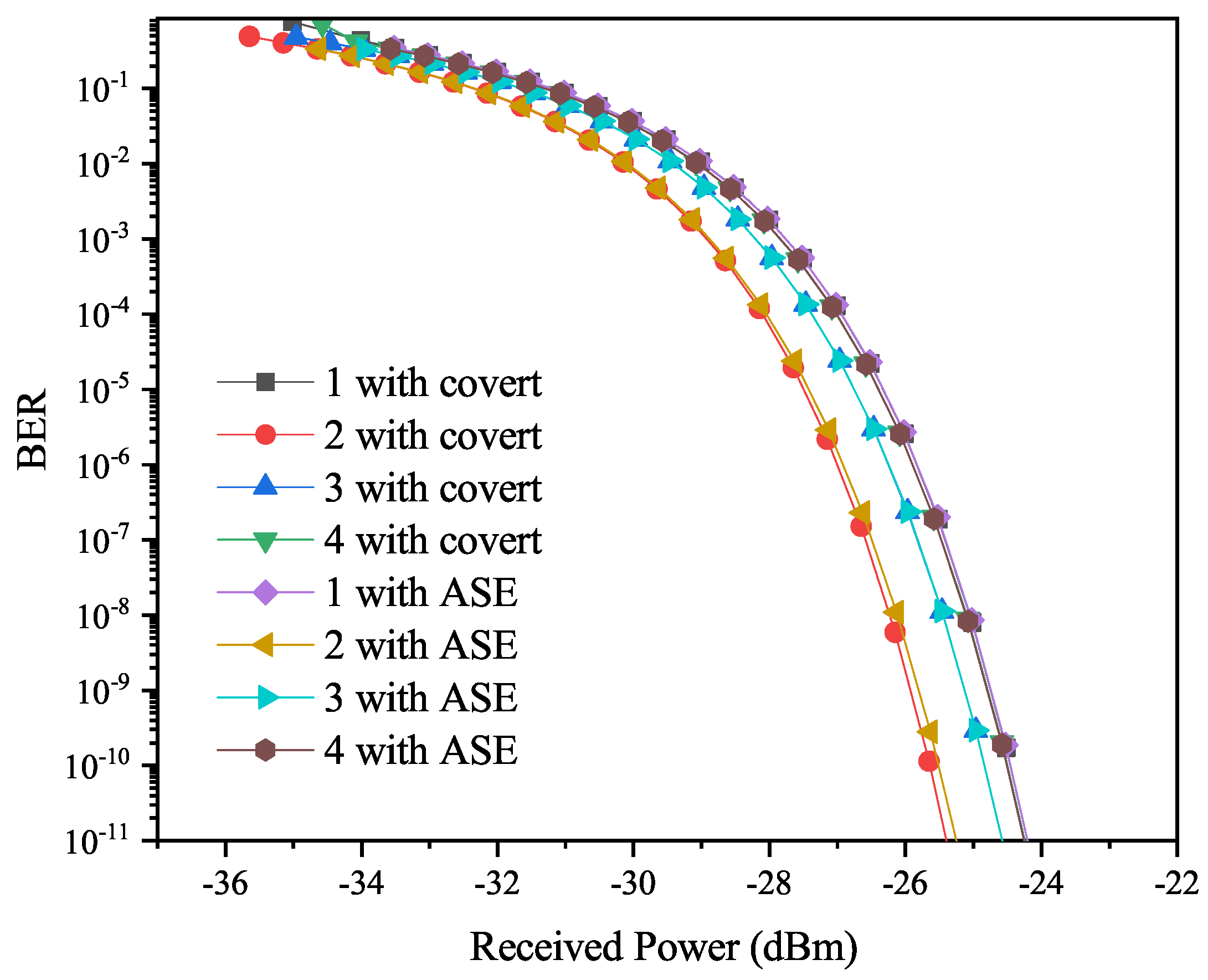
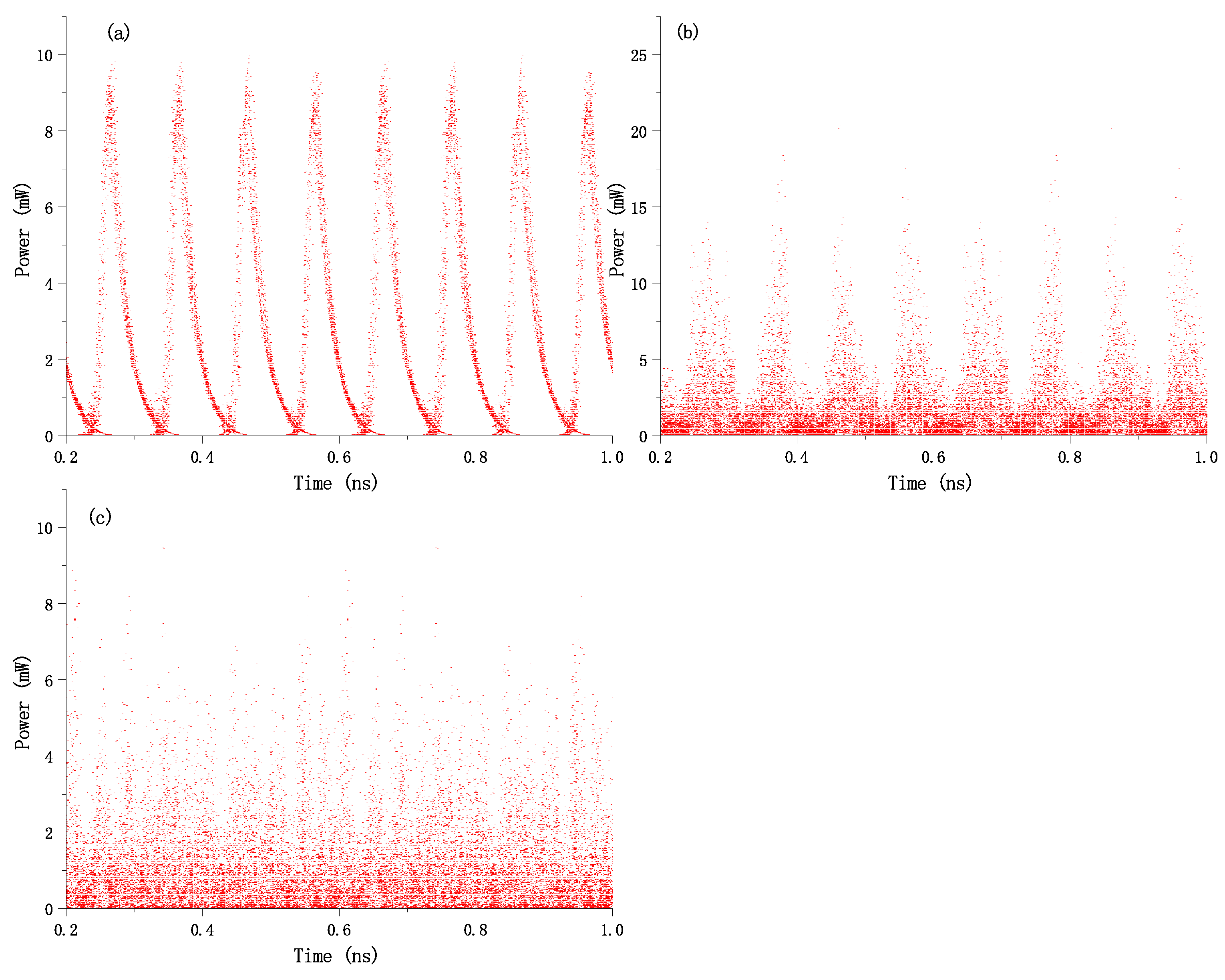
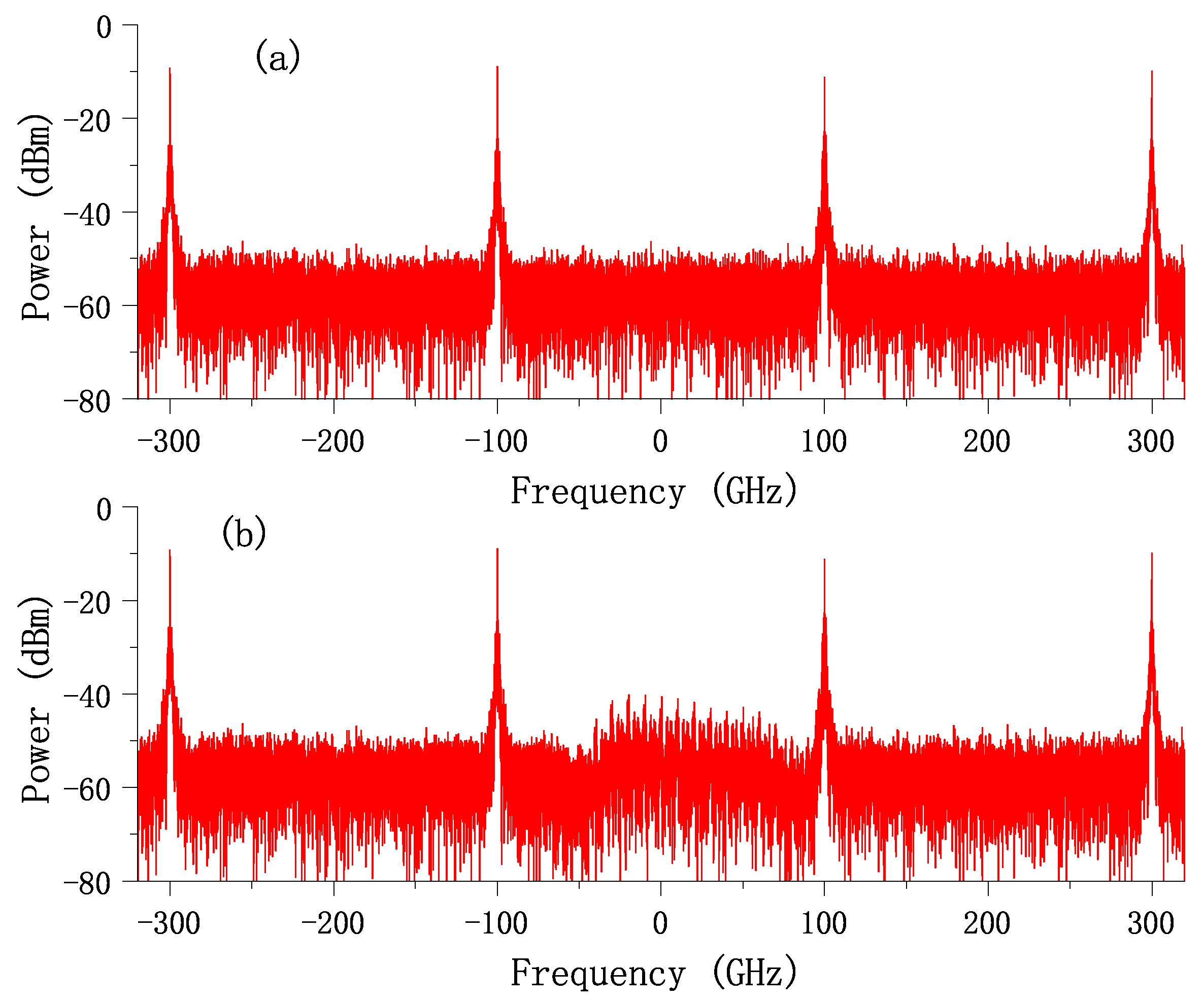

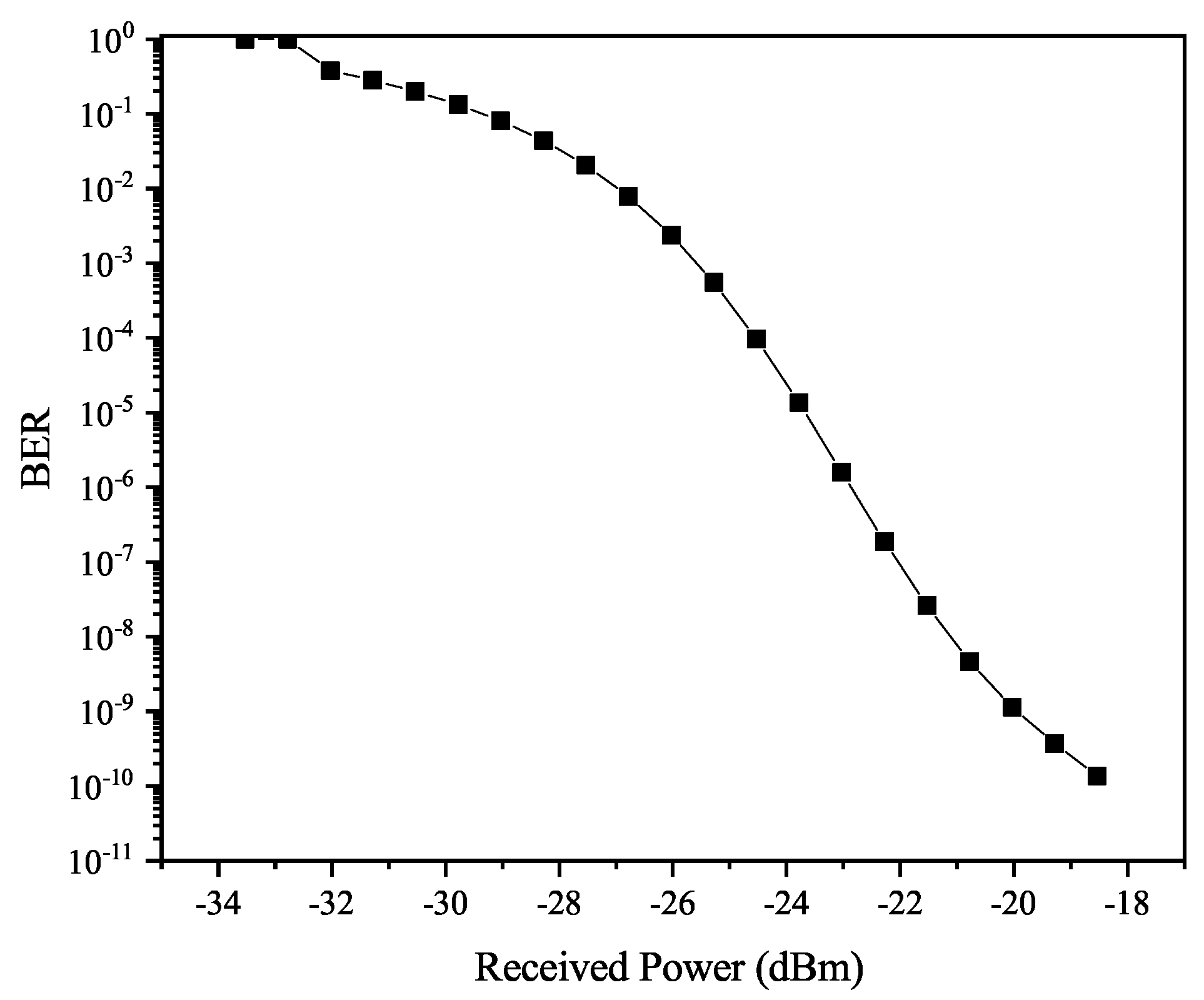
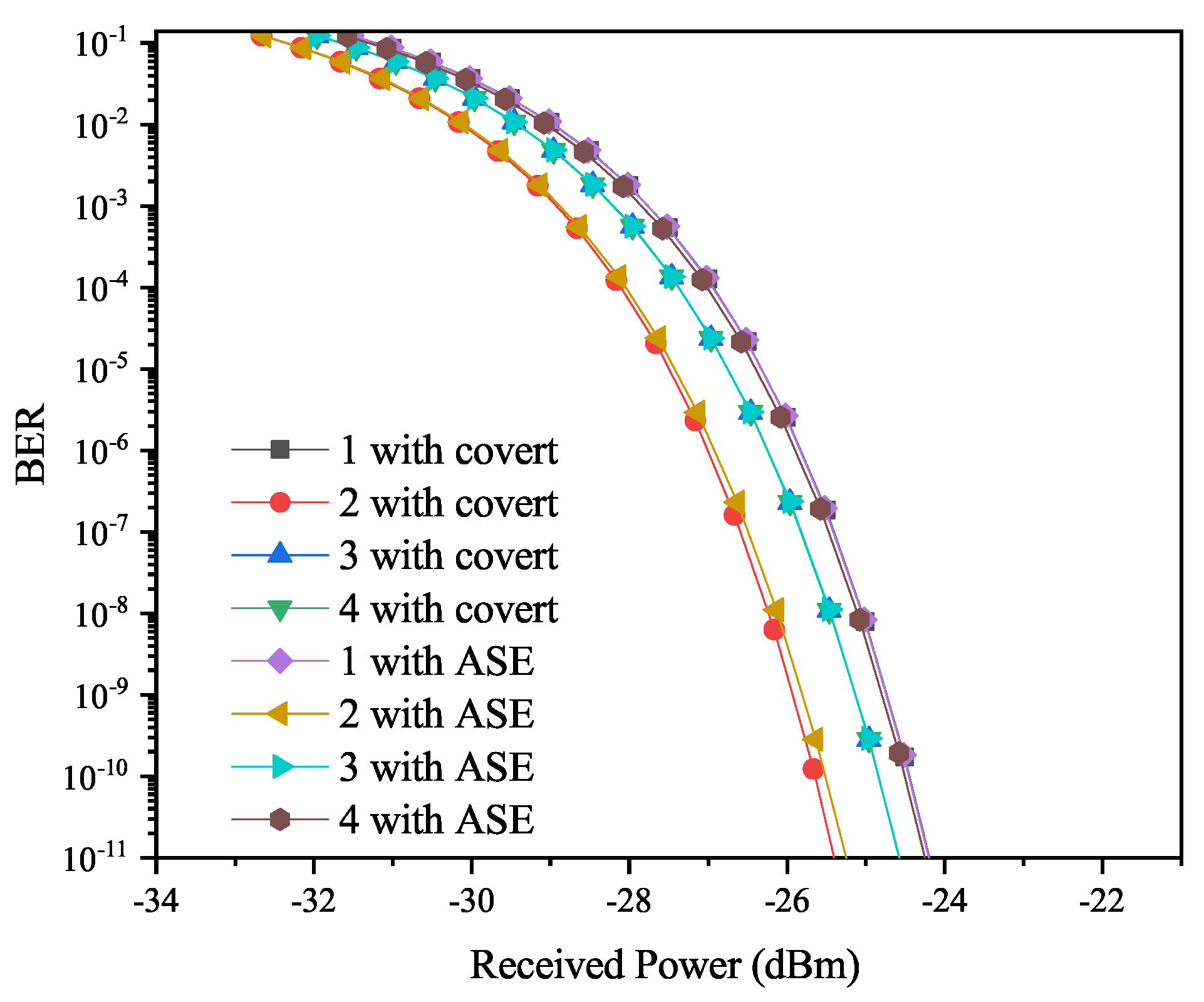
| Parameter | Value |
|---|---|
| Confinement factor () | 0.3 |
| Linear material gain coefficient (a) | m2 |
| Spontaneous emission rate () | |
| Group velocity () | ms−1 |
| Electron charge (e) | C |
| Volume of the active region (V) | m3 |
| Carrier density at transparency () | m−3 |
| Nonlinear gain compact factor () | m3 |
| Photon lifetime () | s |
| Carrier life time at threshold () | s |
| Bimolecular recombination coefficient (B) | m3s−1 |
Disclaimer/Publisher’s Note: The statements, opinions and data contained in all publications are solely those of the individual author(s) and contributor(s) and not of MDPI and/or the editor(s). MDPI and/or the editor(s) disclaim responsibility for any injury to people or property resulting from any ideas, methods, instructions or products referred to in the content. |
© 2024 by the authors. Licensee MDPI, Basel, Switzerland. This article is an open access article distributed under the terms and conditions of the Creative Commons Attribution (CC BY) license (https://creativecommons.org/licenses/by/4.0/).
Share and Cite
Liu, D.; Yin, Y.; Cui, M.; Liu, Z.; Zhu, H. Time-Division Multiplexed Optical Covert Communication System Based on Gain-Switched Optical Pulses. Photonics 2024, 11, 376. https://doi.org/10.3390/photonics11040376
Liu D, Yin Y, Cui M, Liu Z, Zhu H. Time-Division Multiplexed Optical Covert Communication System Based on Gain-Switched Optical Pulses. Photonics. 2024; 11(4):376. https://doi.org/10.3390/photonics11040376
Chicago/Turabian StyleLiu, Dong, Yongliang Yin, Mingyu Cui, Zhanqi Liu, and Huatao Zhu. 2024. "Time-Division Multiplexed Optical Covert Communication System Based on Gain-Switched Optical Pulses" Photonics 11, no. 4: 376. https://doi.org/10.3390/photonics11040376
APA StyleLiu, D., Yin, Y., Cui, M., Liu, Z., & Zhu, H. (2024). Time-Division Multiplexed Optical Covert Communication System Based on Gain-Switched Optical Pulses. Photonics, 11(4), 376. https://doi.org/10.3390/photonics11040376





